One of the special things to do in Luang Prabang is to wake up very early to watch the monks receive alms from the local people. This almsround, known as Tak Bat, is a living tradition for the people in this region, and in many parts of Asia. Monks are not allowed to prepare their own food; they can only eat what is freely offered to them in their begging bowls. They walk through the town at dawn, collecting food, eat a very early breakfast and an early lunch and are not allowed any solid food after noon each day.
I actually know this from direct experience. I attended a 10-day Buddhist monastic retreat several years ago in California – and our final meal of the day was also an early lunch.
Tak Bat is considered a profound act of generosity for the local population. It is the closest interaction between the local people and the monks; feeding the monks is a way that Buddhist householders can receive spiritual merit.
The book in our hotel said this of Tak Bat, “Whenever it is performed, it is done with a profound sense of beauty and affection, with piety, care, thoughtfulness and a deep commitment. Most of the Buddhist believers of Luang Prabang practice this ritual every morning. At sunrise, they prepare the offerings by cooking the rice and kneeling on a mat, in silence, waiting for the monks to approach, their heads and feet bare in humility. They quickly and silently place a small amount of rice in the monks’ alms bowl without making eye contact . . . they do it with joy, knowing it will benefit them, their living or departed relatives, and all beings.
“For their part, the monks meditate on impermanence and on the meaning of the offerings they receive, which symbolize their intentional poverty, humility and dependency on the lay community for their material needs. When they return to the monastery, they share the rice, accompanied by other dishes prepared by the community. They eat this first meal of the day in silence.”
To help us prepare for today’s early morning ritual, Tui spent some time yesterday telling us about the Buddhist monks in the area.
He said that we’d see many young monks on the streets of Luang Prabang and in the internet cafes. For the most part, these are very poor children from the countryside; their parents send them to the monasteries to become novices so that they can get an education. Parents of many of these novice monks can’t afford to educate their children or even feed them, so they apply for their sons (there are very few similar opportunities for girls) to live at one of the local monasteries. At the conclusion of their schooling, many of these young novices return to their families and secular life, but some remain monks for the rest of their lives.
Tui suggested that we talk to some of these young monks since they all want to practice their English, promising that we’d have some pretty interesting conversations. But the book in our hotel room warned, “Though the mini monks are very charming, do beware of giving them your email address as this may be followed up by many requests for money and the latest trainers (sneakers).”
Someone asked, “Were you ever a monk, Tui?”
“Yes,” he said, “for one week.” Tui explained that when his father died, only a new monk could carry his body to be cremated so to fulfill this obligation as a son, Tui became a monk for a week. “I only made it as a novice for a week. Being a monk is a very hard life.” During that week, Tui walked barefoot down the street collecting alms for his lunch, and whenever he’d pass his wife and child kneeling on the street offering food, he’d whisper in their ears, “Tomorrow, chicken. The next day, steak.”
To prepare us to participate in the almsround, Tui told us to be in the lobby at 5:40 AM, to dress respectfully with our knees and shoulders covered. Or as Tui put it, “Any clothes, not so sexy.” He told us we’d be taking our shoes off so we should wear shoes that were easy to take on and off. The almsround would be conducted in silence.
I set my alarm for 5:15 in the morning, eager to participate in this early morning ritual.
We set off in the darkness, following Tui several blocks from our hotel. As we walked in the pre-dawn light, Tui told us, “Many people feed the monks on the main street, but I’m taking you to a place that’s more private with less tourists. With local people on the street.”
When we arrived, we were delighted to see how Tui had prepared a place for us. On a side street, he’d laid out a long carpet, a kneeling pad, and a wicker basket full of sticky rice for each of us. He gave us each a white scarf called a phabieng, which symbolizes being a follower of the Buddha. And he taught us how to wrap it around our chest and one shoulder.
He instructed: “In one hand, you hold the wicker basket and with the other, you take a bit of rice and put it in the bowl. There are seven temples and there are 40-50 monks in each, so you only give each monk a little. When you use up all your rice, close up your basket.” He told us to wait to take pictures until the end, “No one hand on the basket and the other hand on your camera. Wait until you’ve given all of your rice.”
Tui demonstrated handing out a small ball of rice. “The line will start with the oldest monks and at the end of the line will be the little ones. We are giving them rice, but other people in the town will give them other food. They take it all back to the monastery and share it.”
As a cat yowled in heat (a constant sound the week we were in Luang Prabang) and a rooster crowed, Tui gave us our final instructions. “Don’t touch the monk’s bowl. Think of forgiveness at the moment you hand over the rice. Take your shoes off so your body is on the ground. That way the spirit of the earth can see that we are forgiving our enemies, giving alms for our ancestors.”
While we waited, kneeling on our mats, Tui told us how the tradition of feeding the monks in Luang Prabang began. A long time ago, a widow missed her husband very much, and every morning, she made food and brought it to a particular spot, across a bamboo bridge, to offer it up to him. She believed he was eating it in the afterlife. One day, when it was raining very hard, she couldn’t get to the place where she usually made her offerings because she couldn’t cross the raging river to reach her husband’s spirit. At that moment, a monk happened to pass by and she asked if he would take the food to her husband instead. That very night, she had a dream in which her husband told her, “Thank you for the food. Why did you just give food to me today?” He hadn’t received the food she had left for him any of the other days she had offered it–only when the monk intervened and delivered it for her. So every morning, from then on, the widow cooked rice for her husband and brought it to the monks. Word spread and soon everyone was following the widow’s example–and that’s how the tradition of people giving rice to the monks to reach their ancestors began.
As dawn broke and the day grew light, a drum began to sound in the distance. Even though we weren’t on the main street, more and more tourists began to walk by with their cameras. Of course, we didn’t like that. One man even took pictures of us, kneeling there waiting. We, with only a hair’s breadth more knowledge than he had, had become a tourist attraction. I don’t know about the others in our group, but my guess is all of us felt vaguely superior. We were kneeling, properly outfitted, following the rules, with an offering of rice before us. While they were disrespectfully dressed, just waiting for a photo opp. We wished they would go away, but of course we very much wanted to participate ourselves. Isn’t that typical of tourists? We want to enjoy where we are; we just wish all the other tourists would go away.
Mostly, I was grateful that Tui had orchestrated our participation and taught us how to act respectfully. As I saw the first monks come toward us, I started rolling my sticky rice into little balls so I could pass it out more quickly. The monks approached us, from the tallest to the smallest in a beautiful line of orange robes and shaved heads, tipping the lids of their metal bowls open to receive our offerings. Sometimes their bowls were already full of rice; other times, I could see candy bars, bottles of water or other goodies peeking out from the mound of sticky white. In silence, without making eye contact, I quickly added my pre-rolled balls of rice into their waiting bowls. I loved it. I was grateful to have the opportunity to kneel there and support the practice of these monks with my small offering. I offered my rice to “all beings everywhere.” Even though I was a tourist kneeling on a mat, I felt a sense of awe at being part of this tradition, respect for the monk’s practice, and very honored to be a part of it.
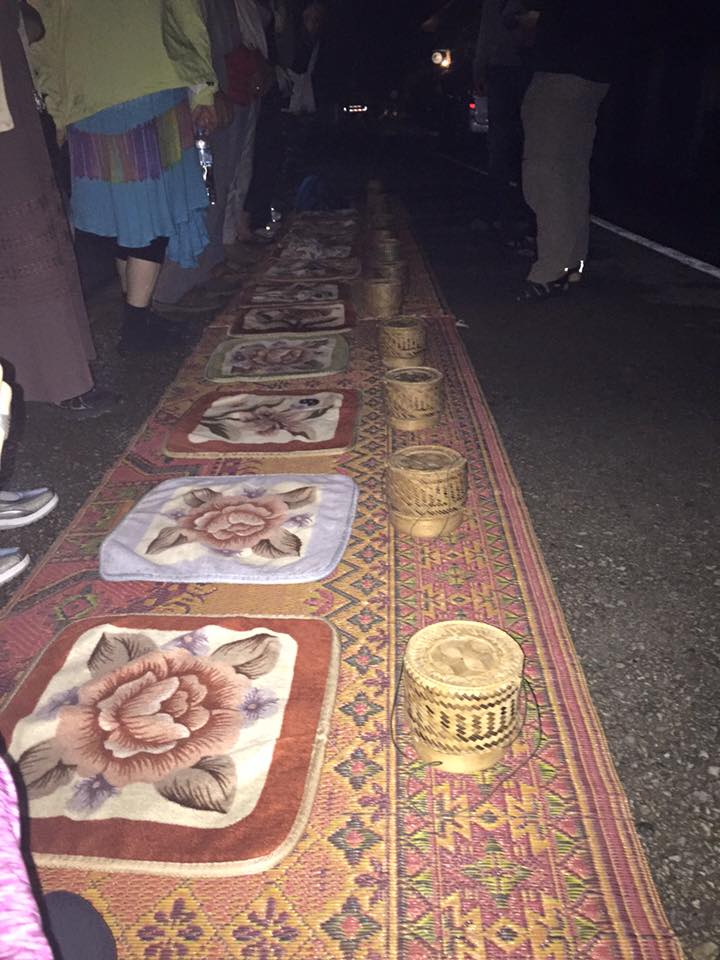
Waiting for the monks…our kneeling place
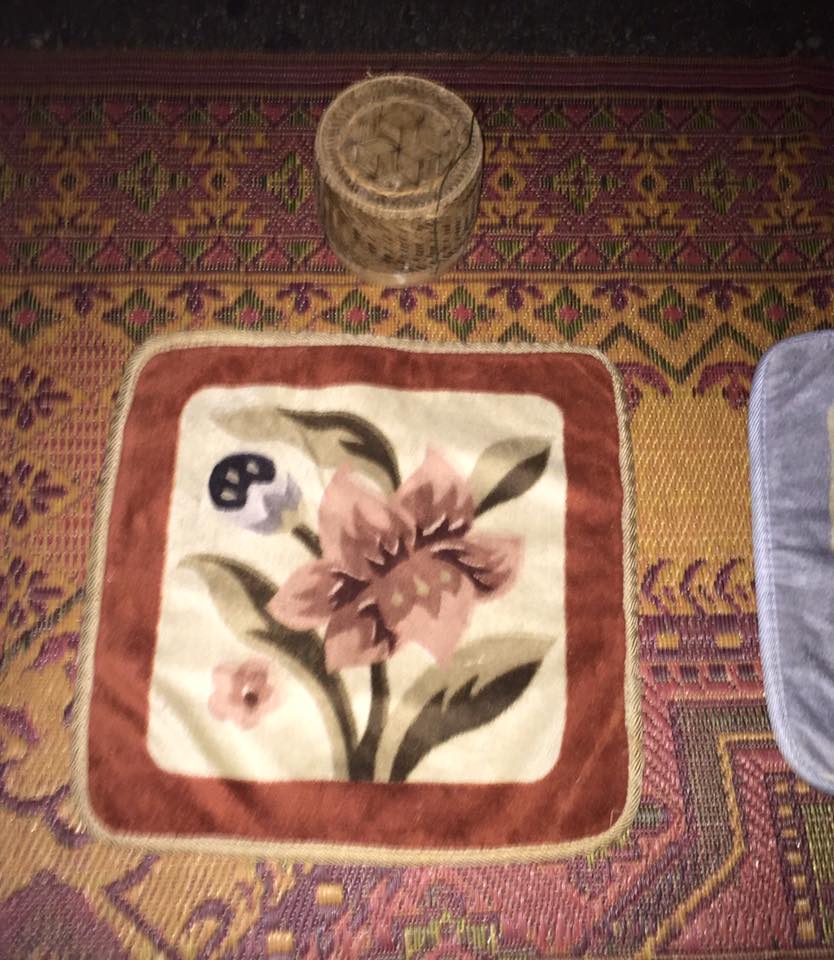
My spot
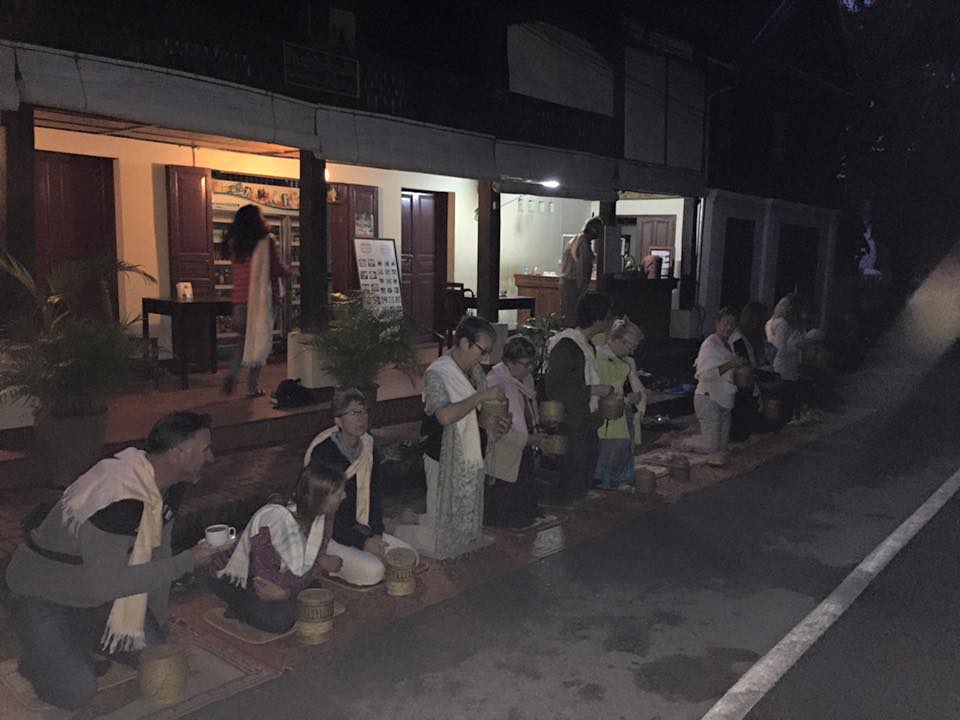
Waiting before dawn
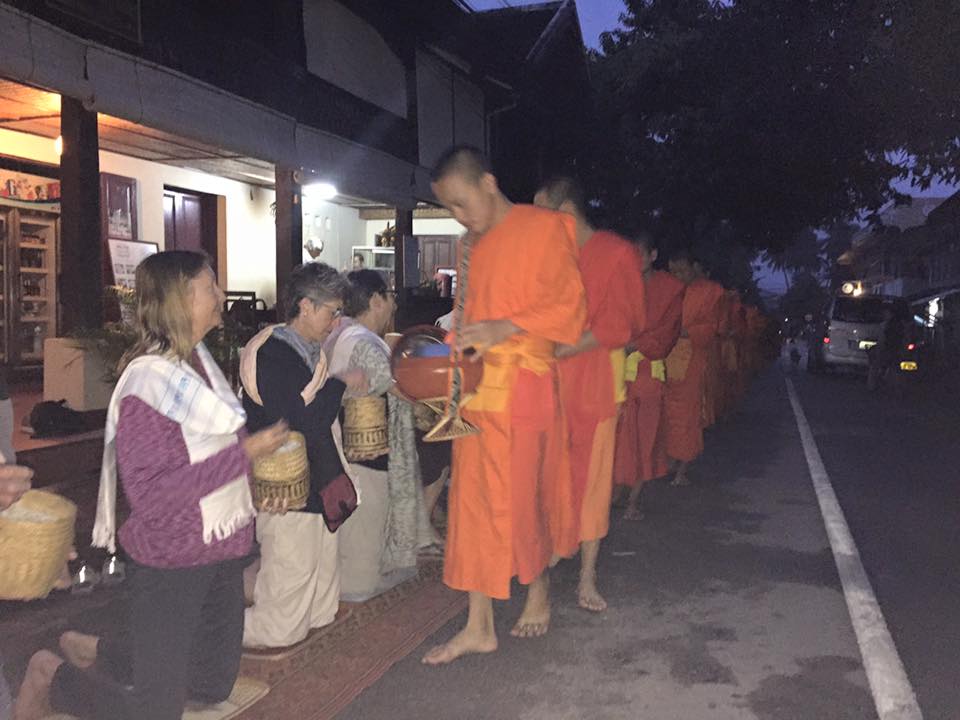
Our group feeding the monks
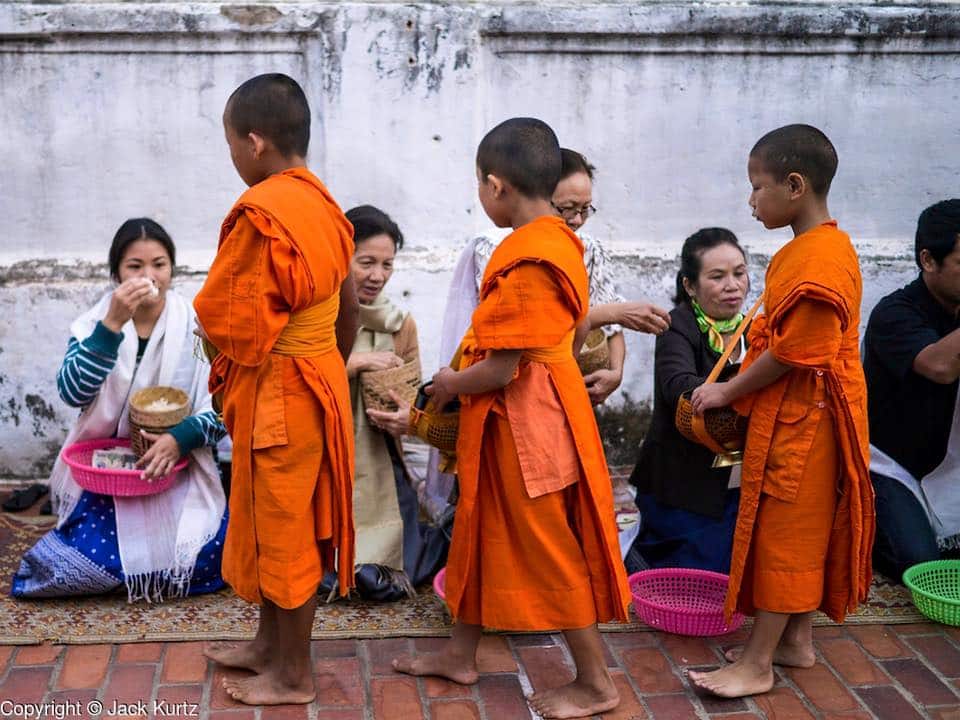
Mini monks
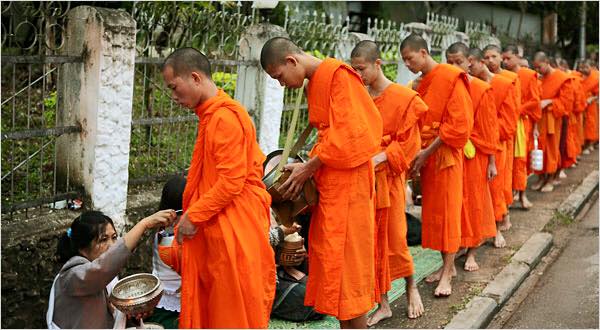
Receiving alms
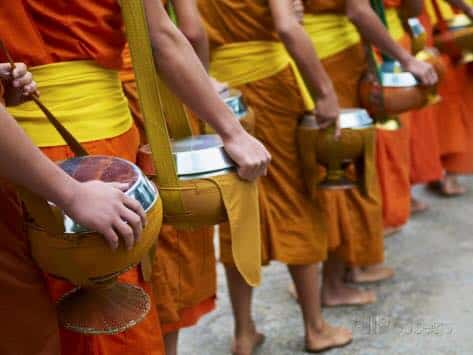
Alms bowls
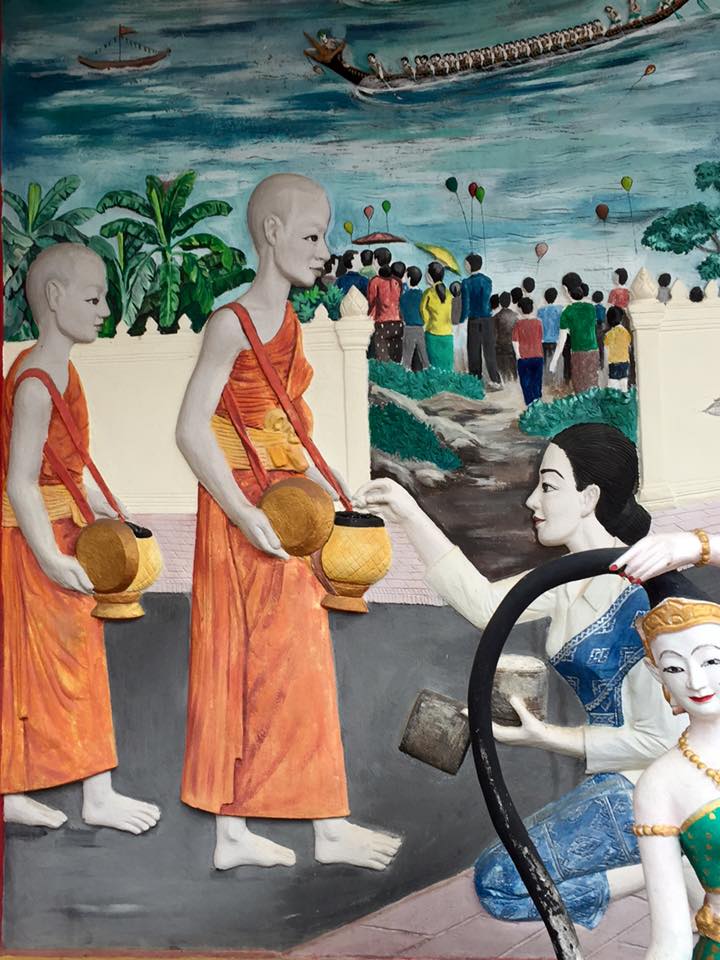
Wall relief on a side street of morning alms rounds
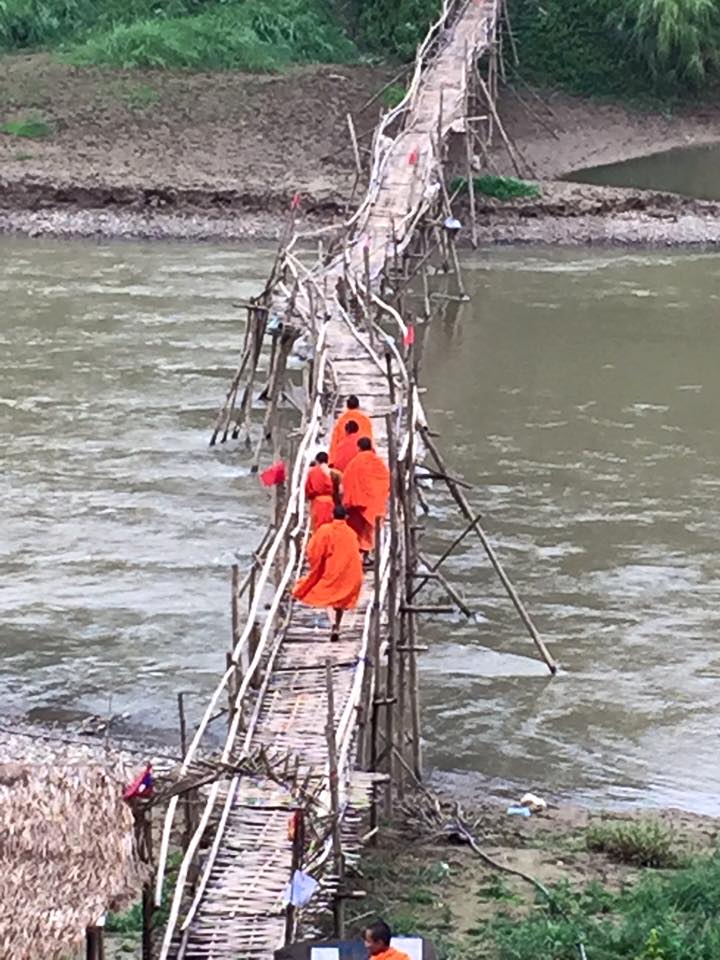
Monks crossing a bamboo bridge

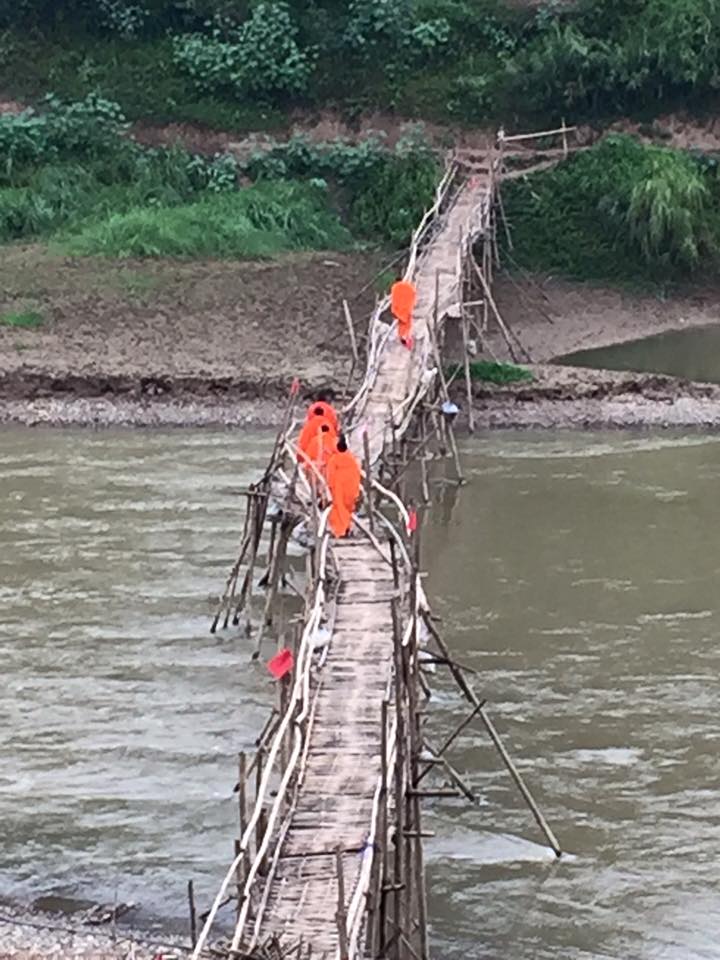
Little did I know I’d be crossing that very same bridge the next day!
